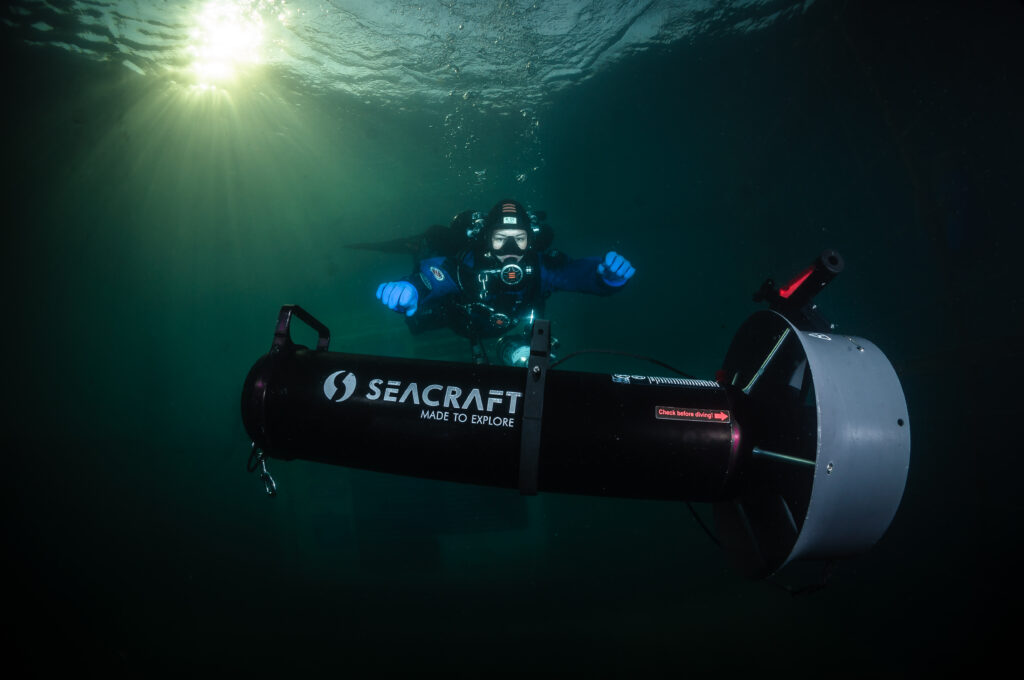| Document level: | Level 0 |
| Scooter models: | All FUTURE / GHOST/ GO! models |
| Document date: | July 4, 2024 |
Procedure information
| Time to complete this procedure: 5-10 min | |
| Tools needed to complete this procedure: – Seacraft service key – Spare trim plates, 1mm and 3mm (optional) – Trim calculator access |
Step-by-step instructions
Introduction
Balancing the DPV means adjusting its buoyancy, to be as desired – usually, perfectly neutral, or slightly positive.
Trimming means adjusting the weight distribution inside, in order to set DPV standing horizontally in the water, and not be nose, or tail heavy. Often, both activities done together are described as ‘DPV trimming’.
This is crucial for a good diving experience. DPV does not change its buoyancy with depth, thus it is done just once before diving.
As the buoyancy of rigid objects depends on water density – salinity and temperature of water highly affect how much weight needs to be added to DPV.

Internal trimming
The most common method of trimming is placing a correct amount of weights inside of the DPV. This is recommended for best DPV streamlining.
In order to trim the DPV internally ;
1. Use our Trim Calculator to calculate the required weight plates changes.
2. Open the DPV, adjust the number of trim weights and if needed – move slightly the battery to the front/back (or use a screw system to position weights, for GO! scooter)
3. Close the DPV, and make sure that all seals and caps are correctly installed. Submerge the DPV, hold it on the tow-harness carabiner to not lose it, and check how it behaves. If needed, repeat steps 1-3 until desired effect.
Trim calculator
The Seacraft balance calculator was designed to assist you in determining the right trim for your DPV with and without accessories. Please remember, that DPV’s trim depends on the salinity and temperature of the waters you are diving in, and on the positioning of the accessories. These factors are taken into account.
Please note, that this calculator is based on some simple assumptions and maybe cannot simulate your specific configuration. Please do also note, that trimming a DPV is no rocket science, but it will depend largely on your personal preference and dive plan. Some divers prefer a slightly positive trim, others a slightly negative one. Hence, always check the correct trim of your DPV BEFORE you dive.
Option 1 – new DPV out of the box
All Seacraft DPVs are delivered trimmed for standard configuration – with transport handle in the front, for freshwater and 20*C. If you want to know how much weight needs to be added :
1. Select your Seacraft DPV model. The calculator will assume that DPV is trimmed ‘out of the box’ – factory trim conditions.
2. Select the waters you are going to dive in. You may select one of the presets or enter your custom value for the salinity.
3. Enter the approx. water temperature (for the depth level, you will spend most of your diving time on).
4. If you are using accessory components on your DPV, select one of the pre-defined mounting points, then select the Seacraft accessory shown at the bottom of the screen. Repeat this step as required for other accessory components.
In the right upper corner, you will now see the expected buoyancy of your DPV and information on how many trim weights to remove or to add. Remember, that the 1mm trimming weights can be easily cut with scissors, in case you need to make very small adjustments.
Please note, that this version of the calculator does not take into account the battery and trimming weight positions inside the DPV. Usually, if adding the weights to position in front of DPV, you need to move slightly back the battery with weights.
Option 2 – changing the water/configuration
If you spend some time trimming your DPV and would like to know what has to be done when for example travelling to another destination, you can use the configuration change option.
Choose the water and configuration that DPV is trimmed in, and click ‘My DPV is trimmed in this configuration’. Now, you can choose target parameters/target configuration and see what changes are needed.
External trimming
You can use dedicated Ballast belts in order to trim Your DPV externally. This is very fast, and allow for quick weight adjustment.
Keep in mind that ballast mounted externally has less effective weight than placed in the DPV body (due to increasing the volume of DPV, and its buoyancy). You need to add aproximatelly 9-10% of weight, when using external trimming.
Factory trim configuration
If you lost your factory trim configuration, and would like to have a starting point, the best method is to use ‘total DPV weight’ as a guideline.
As DPV volume is constant, we can set the ‘total weight’ factor when it will be neutral in freshwater. Take a good quality scale, place your dry DPV on it without a tow harness, and adjust its weight by adding weight plates.
Mount the battery – top lock height from the top of axial pipe is specified.
| DPV model | Power converter | Battery height (cm) | Approximate total weight (kg) | Notes and comments |
| Future Air-Travel 800 | ~3,5 | ~16,19 | With buoyancy foam on the handle | |
| Future Air-Travel 800 | YES | ~3,5 | ~16,19 | With buoyancy foam on the handle |
| Future 1000 | ~3,5 | ~15,86 | ||
| Future 1000 | YES | ~2,0 | ~15,86 | |
| Ghost 1500 | ~7,0 | ~22,86 | ||
| Ghost 1500 | YES | ~6,0 | ~22,86 | |
| Ghost 2000 | ~5,5 | ~22,86 | ||
| Ghost 2000 | YES | ~4,5 | ~22,86 |
In case of questions or problems,
do not hesitate to contact us: service@seacraft.eu.

